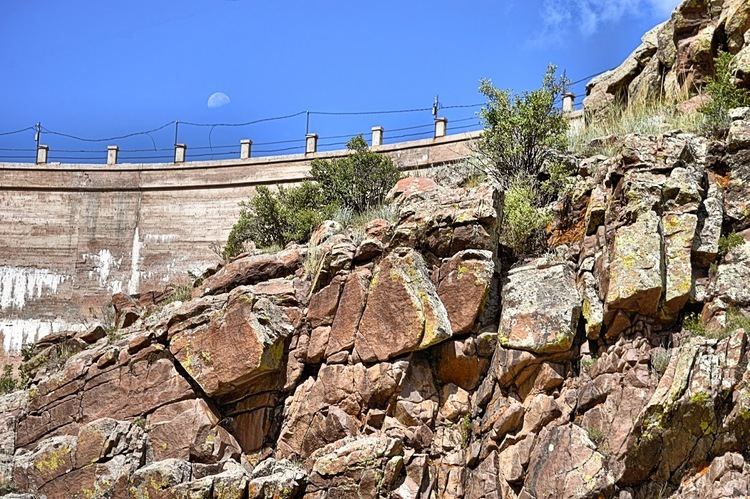Built 1920 (1920) NRHP Reference # 79001537 Designated NMSRCP January 20, 1978 Area 1 ha | Architect Willis Ranney NMSRCP # 549 Opened 1920 Added to NRHP 18 April 1979 | |
 | ||
Similar Eagle Nest Lake State Park, El Vado Dam, Abiquiu Dam, Rio Pueblo de Taos, Rocky Mountains | ||
The Eagle Nest Dam is a dam just east of the town of Eagle Nest, New Mexico on U.S. Route 64. The dam, on private property, is on the Cimarron River, and is responsible for Eagle Nest Lake.
Contents
- Map of Eagle Nest Dam Eagle Nest NM 87718 USA
- HistoryEdit
- Water RightsEdit
- Purchase of Eagle Nest LakeEdit
- References
Map of Eagle Nest Dam, Eagle Nest, NM 87718, USA
HistoryEdit
In 1907, two wealthy ranchers, Frank Springer and Charles Springer, and the Cimarron Valley Land Company were granted a water permit (New Mexico Permit #71) to impound the water of the Cimarron River for irrigation by building a dam. Construction of the dam began in 1916, and continued until 1918. The dam is 140 feet (43 m) high and has an arc length of 400 feet (120 m). At the top, the dam is 9.5 feet (2.9 m) wide, and it is 45.2 feet (13.8 m) wide at the base. It is considered the largest privately built dam in the United States. The resulting lake, known as Eagle Nest Lake has an area of 2,500 acres (10 km2; 3.9 sq mi) and measures 5 miles (8.0 km) long, and 2 miles (3.2 km) wide. The surface elevation of the water when the lake is at capacity is 8,190 feet (2,500 m) above sea level. The reservoir has a capacity of 79,000 acre feet (97,000,000 m3) of water. The dam was constructed by laborers from the nearby Taos Pueblo, and contains no reinforcing steel. The dam sits between two granite walls, and as part of the plans, the Springers had to reroute U.S. Route 64 to its current location, over McAvoy Hill.
To help finance the dam, Springer sold some water rights from Eagle Nest Lake to local farmers and ranchers. These original rights are known as vested rights. In 1951, the State of New Mexico adjudicated the watershed of the Cimarron River. This adjudication confirmed Springer's original permit which gave him the right to store surplus and flood water in the Eagle Nest Lake. There were many other court cases, and one of them ended up in the New Mexico State Supreme Court in 1990.
Water RightsEdit
Today, Eagle Nest Lake still serves its intended purpose as a reservoir, which provides irrigation water via the Cimarron River and a complex canal system, to many farmers and ranchers, some as far as 50 miles downstream. Some of the water rights from Eagle Nest Lake have been purchased by local municipalities including Raton and Springer. The villages of Angel Fire, Eagle Nest, and Cimarron can also get their water from the lake.
Purchase of Eagle Nest LakeEdit
In 2002, the State of New Mexico bought the lake, and it is now operated by the New Mexico Interstate Stream Commission (ISC). After New Mexico bought the lake, various water users approached Governor Bill Richardson in hopes of mediation to end the litigation over water rights. Governor Richardson and the local governing bodies signed the Eagle Nest Water Rights Settlement on June 2, 2006. This settlement specifies that all users share in water shortages. The sharing arrangement is prorated based on the amount of water in the lake on June 1 of each year. All users will be treated equally, including the so-called Tier-Two users who make bulk water purchases. The agreement can be viewed on the web. The lake itself is now operated as Eagle Nest Lake State Park.
